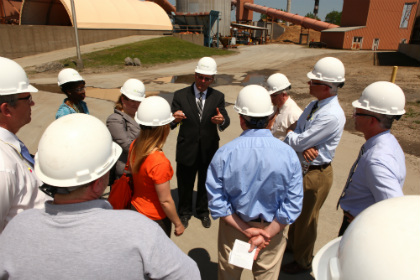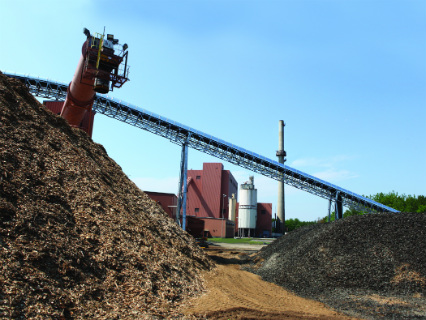
ReEnergy Holdings LLC works with willow growers and uses waste and shrub willow wood to generate electricity.
Table of Contents
-
Introduction
- Shrub Willow Helps Fire Electric Plants
- Working with Willow Growers
- Recycler of Waste Wood
- The Big Picture
- For More Information
- Contributors to this Summary
Introduction
As a vertically integrated renewable energy company, ReEnergy Holdings LLC is an important link in the Northeast’s bioenergy supply chain. Since 2008, the company has provided a market for biomass, such as forest residues, shrub willow, and waste wood, while generating renewable electricity in several large facilities. ReEnergy is also a sponsor of the USDA’s Biomass Crop Assistance Program (BCAP) for willow in central and northern New York, providing opportunities for growers and other bioenergy entrepreneurs.
The company was formed by affiliates of Riverstone Holdings LLC, a private equity firm focused on energy, and a management and investor team. It now owns eight energy production facilities in three Northeast states, six of which are currently operating. Together these facilities have the capacity to generate approximately 300 megawatts of renewable energy, enough to power 305,000 homes per year . They also own and operate four recycling facilities in Massachusetts, New Hampshire and Maine. They also provide jobs to local economies, many of them rural, employing about 300 people.
Shrub Willow Helps Fire Electric Plants
In northern New York State, ReEnergy owns and operates the ReEnergy Lyonsdale biopower facility in Lyonsdale, New York, and the Black River facility at the U.S. Army’s Fort Drum installation near Watertown, New York. In the largest renewable energy project in the history of the U.S. Army, the Black River facility provides 100 percent of the electricity used at Fort Drum, selling additional electricity to the regional grid. ReEnergy has signed a 20-year power supply contract with the Army, ensuring long-term demand for biomass feedstocks in the region (read more here). Approximately 80 percent of the facility’s wood fuel is forest residue from logging operations; the remainder is recovered construction and demolition wood, willow, and tire-derived fuel.

About 1,200 acres of shrub willow established in 2013 and before provides fuel to the two facilities. The majority of it is grown by Celtic Energy Farm, another NEWBio collaborator. Shrub willow is a short-rotation woody crop which has been actively researched for bioenergy and other applications by the State University of New York College of Environmental Science and Forestry (SUNY-ESF) since 1986, and more recently by Cornell University.
Over the first two harvest seasons of the BCAP program, the Lyonsdale and Black River facilities have received abut 2,500 and 540 tons of willow chips, respectively. This experience with commercial-scale willow has given facility operators at ReEnergy new confidence with the feedstock, which has performed well as a fuel in their plants and is now seamlessly integrated and directly mixed with other feedstocks coming into the yard. The amount of willow delivered to these facilities will increase over the next few years as plantings established in 2013 reach the end of the first harvest rotation. Supply of willow could increase even further in future years with the potential for additional willow plantings as the industry progresses.
ReEnergy Lyonsdale and Black River also burn green wood chips for forest residues, most of them obtained within 60 miles of the facilities. To ensure that the fuel they burn is sustainably sourced and harvested, ReEnergy became certified to the Sustainable Forestry Initiative® (SFI®) Standard in 2013; it is the first company solely devoted to electricity production to do so. The certification verifies that the company’s biomass procurement promotes land stewardship and responsible forestry practices. ReEnergy has also worked with loggers to finance chipping equipment, providing more economic opportunities to local businesses and ensuring a more stable feedstock supply chain.
Working with Willow Growers

As part of the BCAP program in northern New York, ReEnergy contracts with landowners and lessees who grow willow on farmland in Jefferson, Lewis, and Oneida counties. These growers produce, harvest, and deliver the final product to fuel yards at ReEnergy’s facilities. ReEnergy pays them a contract price over the 11-year span of the current BCAP project. The BCAP also assists landowners who are early adopters of bioenergy crops by partially subsidising the cost of establishment and providing an acreage incentive payment to landowners in non-harvest years, based on the soil conservation rate of the land on which willow is being grown (visit www.esf.edu/willow for more information).
Over the course of this contract, ReEnergy expects around 75,000 green tons of willow biomass will be produced for use in its facilities. The willow stands have the potential to continue producing biomass for at least another decade after the program is completed (willow bioenergy plantings are typically harvested every three to four years, up to seven times).
The previous BCAP signup period ended in 2013, but ReEnergy plans to sponsor an expansion of the program in this project region if another round of USDA BCAP incentives becomes available under the 2014 U.S. Farm Bill. This would add more growers and willow acreage; meanwhile, more established willow plantings will be ready for harvest soon.
In support of the current BCAP program, SUNY-ESF, in partnership with NEWBio and NYSERDA, provides outreach and extension services to growers and other stakeholders in the project region. SUNY-ESF and NEWBio are also monitoring and researching feedstock quality across the supply chain, willow harvesting and logistics, and the environmental sustainability of willow bioenergy in partnership with the US Department of Energy.
Recycler of Waste Wood

ReEnergy also has a hand in reusing debris left over from the construction and demolition of houses and other buildings. In the last six years, the company’s recycling division has purchased and now operates four facilities for this purpose in New England: one in Lewiston, Maine; two in New Hampshire in the towns of Epping and Salem; and one in Roxbury, Massachusetts.
These facilities process a total of 700,000 tons of construction and demolition debris a year — keeping the waste out of the region’s burgeoning landfills. Employees recover about 70 percent of that waste as asphalt, brick, and concrete; ferrous and non-ferrous metals, and wood chips to fuel energy-generating facilities owned by ReEnergy and others. They also process construction waste into products used by other industries such as asphalt paving, new cardboard and drywall, and recycled plastic and metal products.
“We believe that waste is not something to be discarded into ever-diminishing landfill space, but rather an opportunity to maximize materials that can be recycled and beneficially reused so we may minimize materials that are landfilled,” said Sarah Boggess, director of communications and governmental affairs for ReEnergy.
ReEnergy also operates four electricity-generating plants in Maine that burn biomass from green wood, such as forest residue from the surrounding areas. Two of the plants, in Ashland and Stratton, are located next to sawmills and also burn mill residue. ReEnergy also has two facilities that are idle for the time being: a biomass-fired generating facility in Chateauguay, New York, and one in Sterling, Connecticut, which had burned discarded tires and biomass material until October 2013, when it was closed for economic reasons. These plants may come online again in the near future, depending on possible renewable energy incentives, energy sales agreements, and energy prices.
The Big Picture
Energy prices are volatile, and renewable energy policies and incentives also face an uncertain and changing future. This can have a large impact on the viability of renewable bioenergy. Still, stable, long-term demand for biomass in the region has been secured through ReEnergy’s 20-year contract with the U.S. Army through 2024, contributing to the Army’s goal of 1 gigawatt of renewable energy by 2025, the Energy Policy Act of 2005, Executive Order 13423, and the Energy Independence and Security Act of 2007.
ReEnergy’s New York plants will also play a role in New York’s renewable portfolio standard administered by NYSERDA, a program that is tasked with obtaining 30 percent of New York’s electricity from renewable sources.
Willow bioenergy, sustainably harvested forest residues, recycled construction debris, and other renewable feedstocks provide a diverse range of fuel sources and economic benefits. ReEnergy is well placed to continue as a leading player in the Northeast’s renewable energy industry and contribute to several larger intiatives on the state and national levels.
For More Information
ReEnergy Holdings LLC
NEWBio Project Resources – information on the research, opportunities and challenges in developing a sustainable system for the production of biofuels.
The Willow Project at SUNY-ESF – tools and resources for the successful production of shrub willow.
Willowpedia: Willow Energy Crop Information Resource at Cornell University.
Contributors to this Case Study
Authors
- Susan J. Harlow, Freelance Journalist
Peer Reviewer
- Robert C. Brown, Anson Marston Distinguished Professor of Engineering and Gary and Donna Hoover Chair in Mechanical Engineering, Iowa State University
- Justin Heavey, Senior Research Support Specialist, Willow Project Research Group at SUNY ESF
 The Northeast Woody/Warm-season Biomass Consortium – NEWBio is supported by Agriculture and Food Research Initiative Competitive Grant no. 2012-68005-19703 from the USDA National Institute of Food and Agriculture.
The Northeast Woody/Warm-season Biomass Consortium – NEWBio is supported by Agriculture and Food Research Initiative Competitive Grant no. 2012-68005-19703 from the USDA National Institute of Food and Agriculture.
Led by Penn State University, NEWBio includes partners from Cornell University, SUNY College of Environmental Science and Forestry, West Virginia University, Delaware State University, Ohio State University, Rutgers University,  USDA’s Eastern Regional Research Center, and DOE’s Oak Ridge National Laboratory and Idaho National Laboratory.
USDA’s Eastern Regional Research Center, and DOE’s Oak Ridge National Laboratory and Idaho National Laboratory.
